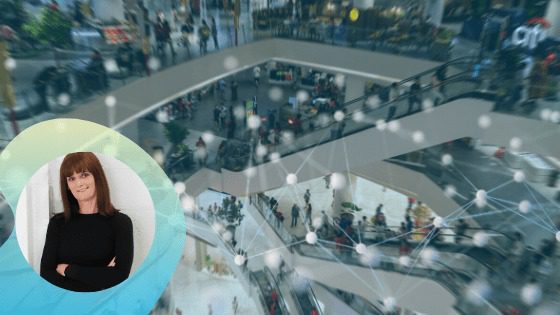With 30+ years of experience in the retail industry, including her prior position as VP of Customer Experience Design at Lowe’s Companies, Ruth Crowley is hyper-focused on the customer psyche and how that will change — not just in the travel sector but in all retail and service channels. Now serving as VP of Merchandise and Brand Strategy at Hudson Group, she has a distinct viewpoint on how brands must focus on personalizing experience to ensure consumers are comfortable when they venture back to stores.
Retail TouchPoints (RTP): How is Hudson Group managing during the crisis?
Ruth Crowley: We are a travel retailer and strive to be a trusted friend to the traveler. That objective just became more important. We are connected to what is going on with the airlines and TSA, which is a great data source. We have an invaluable team still working on the ground in operations. The collective intelligence will help inform our strategy. With the dramatic decline in traffic we will need to be more conscientious and agile when re-opening stores.
For all retailers, just putting product on sale will not motivate consumers to come into crowded stores. The overall experience just became much more important. The customer experience is not an initiative but an imperative. We are continuing to have conversations every day with key partners to make sure we are ready to move when it is time. Radical collaboration is critical. We cannot allow the vertical lines within the organizational charts to be a barrier in a horizontal process. Collaboration is multiplication. Retailers will have to embrace the idea of unifying the process throughout the customer journey to elevate results.
As we begin to open, we will have to recalibrate the model. We will make sure we have PPE products including masks, gloves, hand sanitizer, wipes, etc., to serve the traveler. Every retailer will have to define how their model changes to serve the changing psyche of the Customer.
RTP: What is the most important priority for businesses in the retail and hospitality sector looking to survive through the COVID-19 crisis?
Crowley: Companies will have to reprioritize priorities. Communication is critical — with employees, brand partners, stakeholders and suppliers. Before the customer starts re-entering stores, we need to ensure associates on the front lines are comfortable. The cliché, ‘If you’re taking care of your people the people are taking care of the customer’ just became a lot more important.
Many companies cannot speak directly to their associates as some are on furlough. The conversation has to begin on a human level where front-line personnel believe they are a critical link in the service chain. With such a high level of economic uncertainty, people can be the difference in being the company of choice for the customer. I would absolutely recommend a more disciplined approach to co-creating a 360-degree experience for the customer.
Putting the customer at the center of the process and building the strategy to support that (versus defining how to make the customer buy what we want them to buy) will drive optimal results. These are the items retail organizations should prioritize:
- Safety;
- Customer and Associate re-engagement;
- Opening operations;
- Merchandise and Clearance; and
- Agility.
RTP: How should retailers be more effectively communicating with customers right now?
Crowley:Retailers have a unique opportunity to leverage data gathered throughout the COVID virus. Analyzing data and identifying patterns in purchasing behavior could help identify opportunities on how to personalize the experience so customers are compelled to shop. As businesses open, retailers need to make the shopping journey more seamless across the ecosystem.
How do we simplify the process to amplify the experience? There is a definite value in Artificial Intelligence (AI) and machine learning, and leveraging customer intelligence to drive exponential growth. There is no way to get everything done, so a focused, purposeful, cross-functional effort, prioritizing opportunities will help prompt small steps to big gains. Sounds simple, but it’s not easy!
We have to figure out how to make the communication more personal and “human”: 70% of customers say a more personalized approach is a key factor in determining where to shop. If we make the shopping journey frictionless, essentially contactless but still feel more high touch, we create an emotional connection. Emotion drives behavior. Fully engaged customers spend more than 20% more and the LTV (lifetime value) is up to 30% higher. The opportunity is real but as yet, still unrealized.
RTP: What are some of the disciplines you employ that might help Retailers survive and thrive?
Crowley: I focus on Six Key Disciplines, putting the customer at the center. Those disciplines are:
- Define the Go-Forward Strategy: What is the blueprint for success?
- Understand the Customer: Do you really “get” your customers? Who is your target?
- Employ Experience Design: Being on emotion is just as important as being on message, especially now. Design includes a set of practices including research and analysis that are clear, specific, relevant and scalable. Everyone is accountable.
- Measure Customer and Associate Behavior: Not just sales numbers, but also engagement.
- Prioritize Business Governance: Including discipline, focus, accountability and socialization.
- Revitalize Business Culture: Look at the customer experience with a 360-degree view. Consider what is needed to change mindsets, gain support and build momentum. This may require upskilling Associates and rethinking hiring practices. It is a journey.
RTP: What is one of the most significant impacts of the virus on retail business strategy?
Crowley: Acceleration. Everything needs to be accelerated. Generally, we describe a one- to three-year strategy. There is no time for that! It is no longer prudent to wait to innovate or improve operations, technology, marketing and business strategy. Capital is likely not readily available at least until next year, so we have to work with what we have — go a level below the surface and raise the game in terms of connection with the customer to drive results. Example: we have the inventory — how do we engage with the customer to highlight the value and relevance of the inventory to their unique needs?













